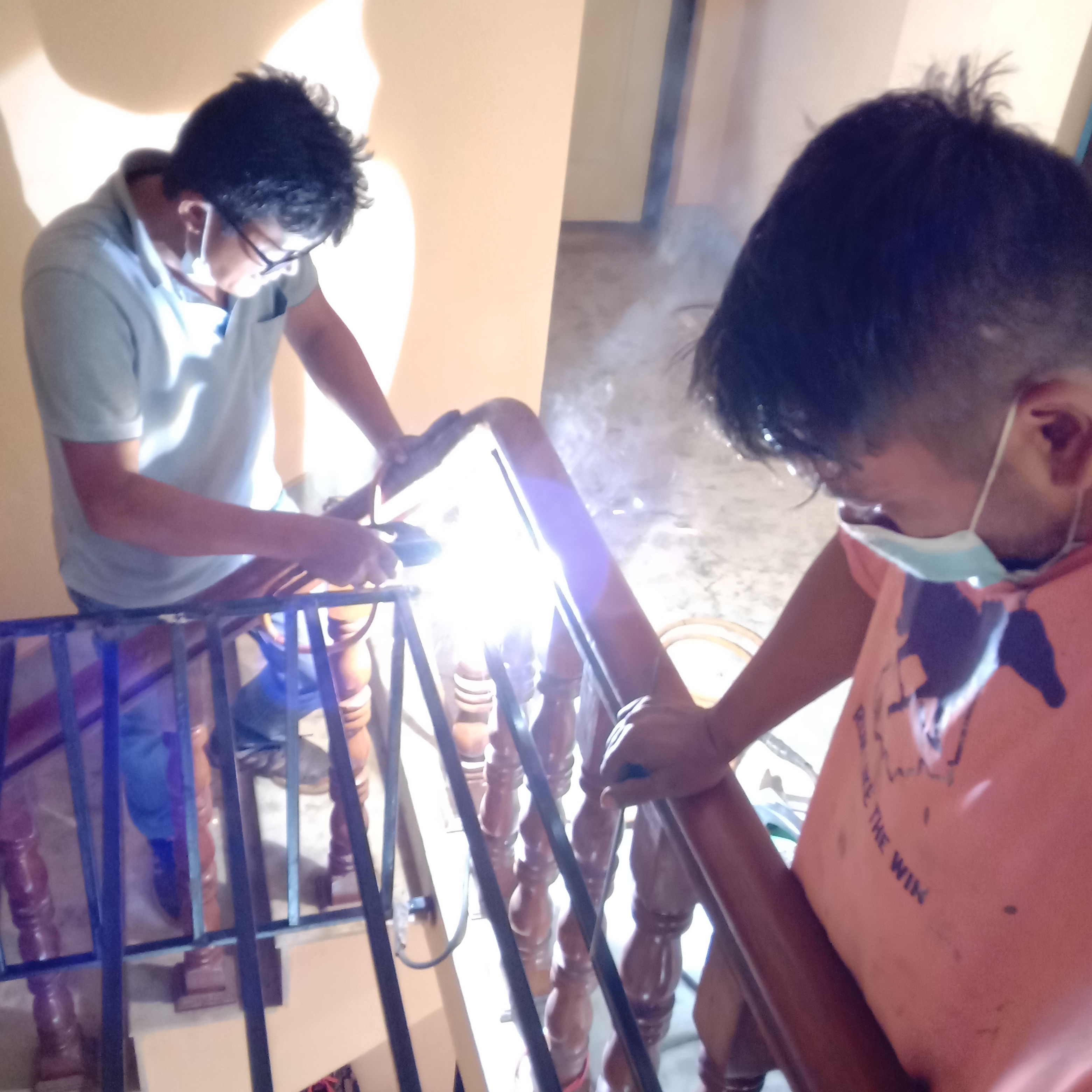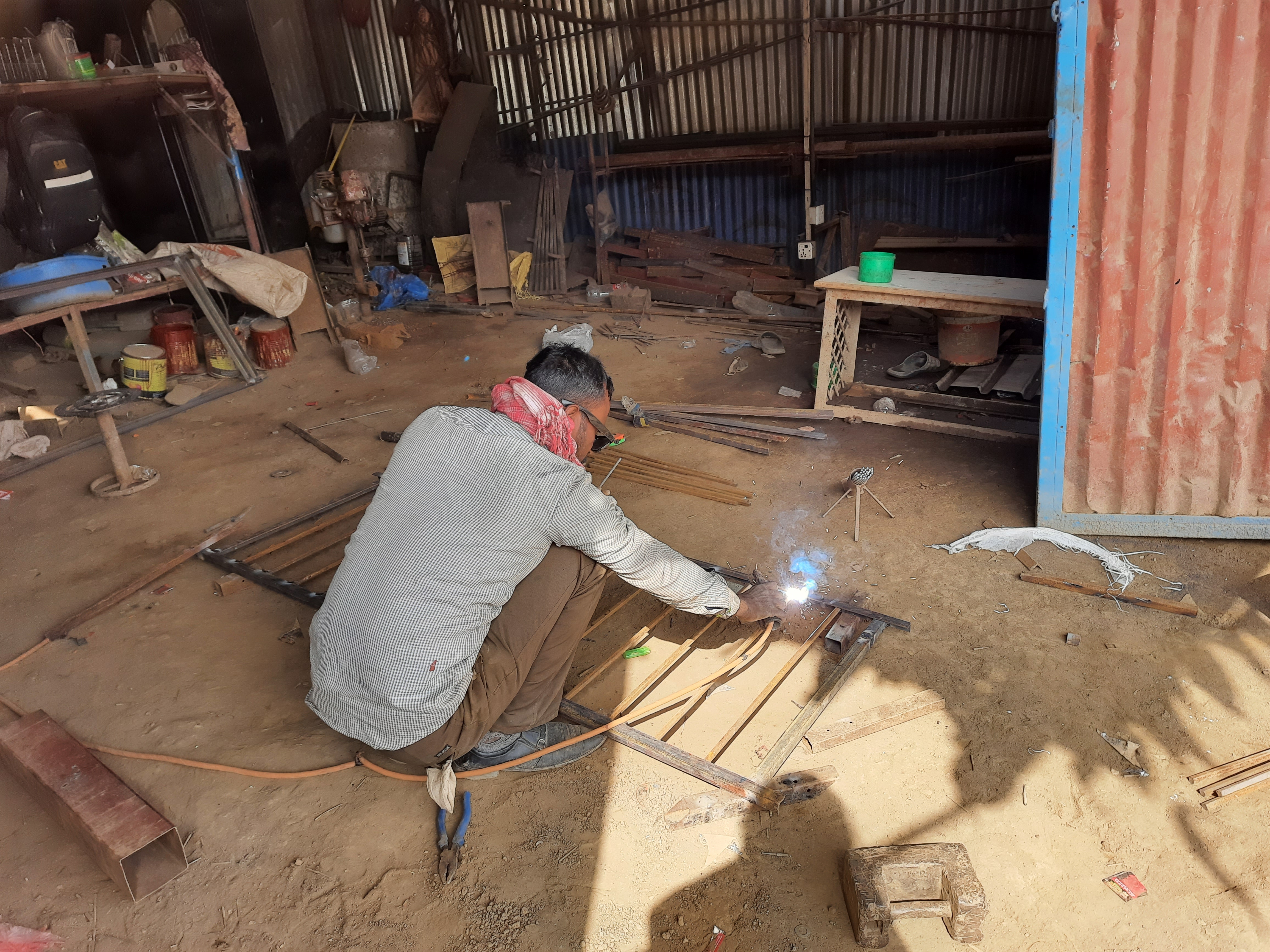Study, Awareness and Policy Advocacy for the prevention of Occupational Exposure to Welding Fumes among Metal Fabricators in Nepal.
 |
Center for Public Health and Environmental Development (CEPHED) | |
 |
Ram Charitra Sah | |
 |
http://cephed.org.np/ | |
 |
US$5,000 |
Research Background Final Report (abstract) Others

Welding workers

Welding workshop
Research Background
Welding fumes are a complex mixture of metals, metallic oxides, silicates and fluoride. When a metal is heated above its boiling point, its vapour condense into very fine particles, forming fumes (solid particulates). Particles from the electrode and the welded material are common in welding fumes.
Eye, Nose and Throat (ENT) irritation and respiratory tract infection are the major health implications and surrounding environmental pollution etc. are the major problems. Prolonged exposure to welding fume may cause lung damage and various types of cancer, including lung, larynx and urinary tract. Health effects from certain fumes may include metal fume fever, stomach ulcers, kidney damage and nervous system damage. Prolonged exposure to manganese fume can cause Parkinson’s?like symptoms. Gases such as helium, argon, and carbon dioxide displace oxygen in the air and can lead to suffocation, particularly when welding in confined or enclosed spaces. Carbon monoxide gas can form, posing a serious asphyxiation hazard are the direct observable implications out of using different kinds of welding rods. These workers need to be protected from its ongoing occupational exposure of toxic fumes coming from welding rods. In fact, there is neither any safe exposure limit being adopted by the Government of Nepal nor any standards specification of the welding rod has been enacted yet.
Welders are unknowingly exposed to several toxic welding fumes in Nepal, thus this project with the support of the Takagi Fund for Citizen Science is aims at generating health and environment-based data that will be widely used for the awareness raising as well as policy advocacy for the required regulatory framework.
This project will directly and indirectly benefit currently about 2000 Grill and Steel Fabricators Workshops are being registered and in operation, created about 20,000 jobs and benefitting around 20,00,000 depending family members throughout the country in Nepal as it is one of the emerging sectors of Occupational Health and Safety (OHS) with a lot of potential of replacing the demand of forest wood and thus environment destruction.
Objective
Following objectives are intend to achieve to address the issues through promoting citizen science in Nepal;
a) Study of welder’s exposure level to welding fumes and their lungs function test.
b) Study of Workers perception about their health and environmental impacts of welding fumes.
c) Raise awareness among the welding workers and their federations by sharing the research findings through workshop and mass & social media.
d) Advocate with the government to promulgate Standards of Welding electrode/ rods and personal exposure limits etc.
Methodology
Following methodology will be followed to achieve the objectives.
a) The questionnaire survey with Metal Fabricators (50) to understand their perception and awareness level and health as well as environmental implications from the metal fumes.
b) The measurement of personal exposure level using personal samplers (10 Workshop)
c) The Spirometry test among 50 Welding workers with longer working history people to check their lungs functions related implications.
d) Result analysis using statistical package and report preparation and dissemination through organizing workshops (Face to face and/or online looking at the COVID19 pandemic).
e) Sharing the research results and workshops outcomes through mass and social media as well as through the specific EHS websites too.
Impact and Expected outcomes on society
The welding workers level of exposure will be known that help to envision to adopt the regulatory and technical measures required to solve the problem so as to prevent and reduce the ongoing exposure to the welding fumes to the metal fabricators.
Level of awareness among the metal fabricators will be known to envision the mass awareness programs that will help the welders to prevent their exposure as well as reduce environmental burden of these toxic fumes.
Health and environment related implications will be known that will help to fabricators as well as communities to be prepared for all possible prevention and control measures to be taken to avoid further exposure.
Effective implementation of enacted standards and other regulatory mechanism in place will improve the health and environment condition of the surroundings.
Welding workers will be protected from getting exposure to toxic fumes.
Research based formulation of standards and exposure limit fixation will ensure effective implementation as well as provide sustainable solution to the problems.
[Sep. 2021]
Final Report (abstract)
Center for Public Health and Environmental Development (CEPHED) in collaboration with the Government of Nepal Ministry of Labour, Employment and Social Security (MOLES), Department of Labor and Occupational Safety (DoLOS), Occupational Safety and Health Center (OSHC), Nepal Grill and Steel Fabricators Federation (FGSFN) and SMS Environment and Engineering Private Limited conducted a study on 'Welding Fume and Occupational Safety and Health' by taking 21 samples from 11 industries operating in Kathmandu Valley.
Under this research measuring personal exposure of the workers to the toxic welding fumes by personal samplers, metal characterization of respiratory illness through pulmonary function test (PFT) of the welding workers was tested, analyzed, prepared, and released through organizing a workshop.
The study, awareness, and policy advocacy for the prevention of occupational hazards caused by welding fumes were completed by the Center for Public Health and Environment Development with the financial and technical support of Takagi Fund for Citizen Science, Japan, and Developing World Outreach Initiative (DWOI), USA. The report published based on the study of the occupational safety and health effects of the welding fume was released on Saturday, July 30th, 2022 with the participation of over 100 grill industrialists and workers from different parts of the country through a workshop in collaboration with Grill and Steel Fabricators Federation of Nepal, the umbrella organization of grill and steel fabricators across Nepal. Program under the chairmanship of Grill and Steel Fabricators Federation President Mohan Katuwal and Senior Officer of Occupational Safety and Health Center Satish Kumar Upadhyaya and Senior Vice President of Grill and Steel Fabricators Federation Niranjan Kumar Shrestha along with the gracious presence of the presidents of all the district committees of fabricators was completed.
The results obtained from the study, its effects, and the three policy, industry, and workers level recommendations for mitigation and control measures for the welding fume-related OSH were presented in detail.
21 welding samples were collected from different 11 welding workshops in Kathmandu, Lalitpur, and Bhaktapur. According to the study, 52% (21 out of 11) were collected from 11 welding workshops and laboratory-tested fume samples exceeded the American Conference of Governmental Industrial Hygienists (ACGIH) guideline standard of 5 mg/m3. Thus it revealed that workers working in more than 50% of welding workshops are at high risk of welding fumes.
Also, when analyzing the toxic metals in the welding fumes, iron, and manganese were found in 100% of the samples, while chromium was found in 19%, nickel, and copper in 71.42%, and zinc in 85.71% of the samples. In two samples, iron was found more than the TLV (Threshold Limit Value) standard (5 mg/m3) and in eighteen samples magnesium was found more than the TLV standard (0.02 mg/m3). Chromium was found to exceed the TLV standard (0.003 mg/m3) in one sample.
Pulmonary function test (PFT) results were analyzed in a total of 88 welders and 108 controls. Which, 41.46% of the workers were found in the life-threatening group, 20.23% in the acute severe group, and 27.31% in the moderate exposure group, these showed that their health condition is under severe threat, and needs to be protected.
Mandatory use of full personal protective equipment (PPEs). Regular occupational safety and health (OSH) training and public awareness should be promoted among welders. There is an urgent need to define and recognize the work of welders as hazardous work. Labor laws (acts, regulations, policies, etc.) should include specific provisions regarding the occupational exposure of welders to the protection of welding fumes. It should be made mandatory to submit periodic health surveillance reports of all welders to the Department of Labor and Occupational Safety (DOLOS). To ensure the professional safety and health of the workers working in the welding business, the standards of the welding rod (electrode) and the exposure limits that come into contact with the smoke should be implemented as effectively as possible. Quite smoking among the welding would be beneficial to mitigate the welding fumes impacts.
[Jan. 2023]
Others
